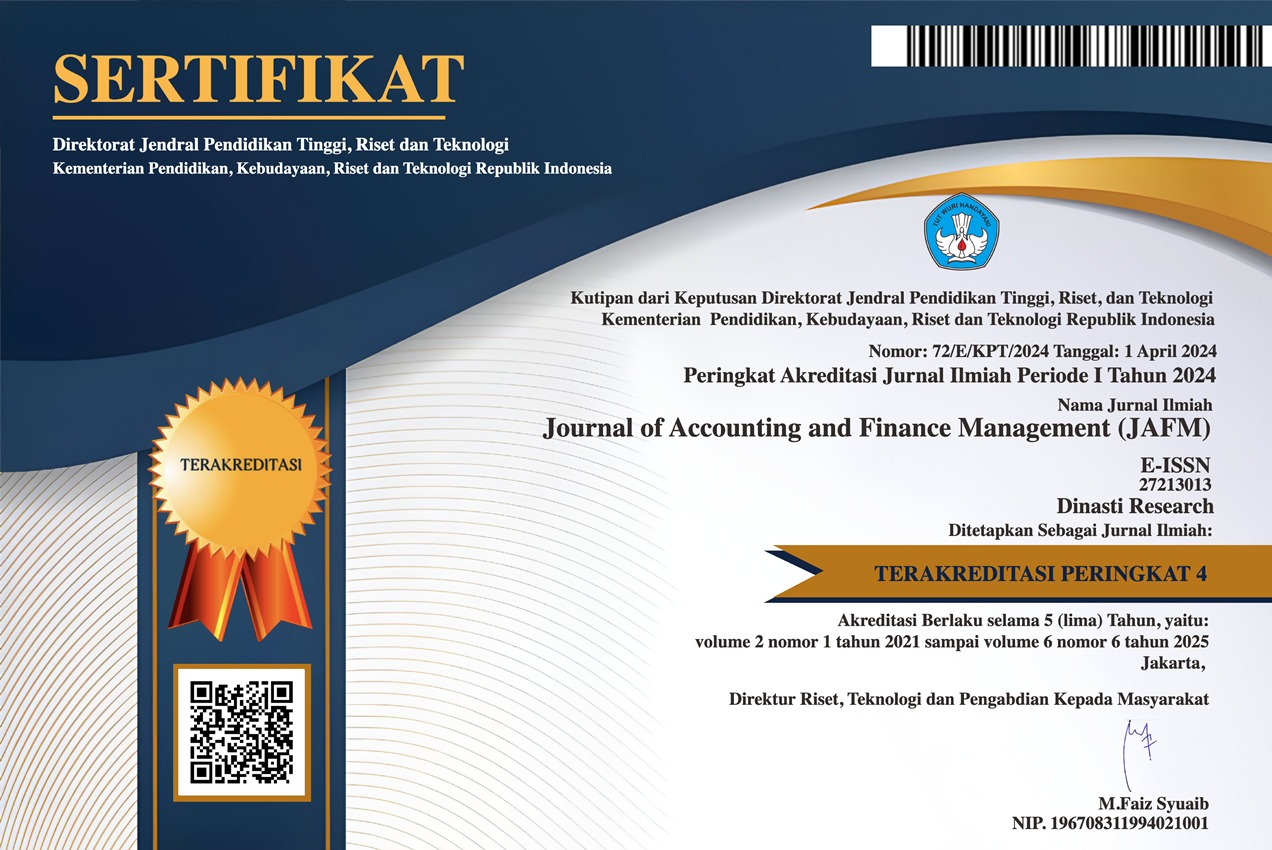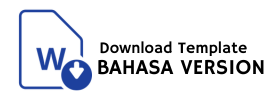Company Growth, Komite Audit, Komisaris Independen, Cash Flow dan Dividend Payout Ratio terhadap Konservatisme Akuntansi
DOI:
https://doi.org/10.38035/jafm.v5i6.1295Keywords:
Accounting Conservatism, Company Growth, Audit Committee, Independen Commissioner, Dividend Payout RatioAbstract
Konservatisme merupakan prinsip kehati-hatian dalam pelaporan keuangan dimana perusahaan tidak segera mengakui dan mengukur aset dan laba tetapi segera mengakui kerugian dan utang yang mungkin terjadi. Penelitian ini bertujuan untuk menganalisis pengaruh company growth, komite audit, komisaris independen, cash flow, dividend payout ratio terhadap konservatisme akuntansi pada perusahaan non keuangan yang terdaftar di bursa efek indonesia periode 2020-2022. Teknik pengambilan sampel yang digunakan pada penelitian ini adalah purposive sampling. Sebanyak 273 perusahaan yang telah memenuhi kriteria sebagai unit observasi. Metode analisis yang digunakan adalah analisis regresi linier berganda. Hasil penelitian memberikan bukti empiris bahwa komite audit, komisaris independen, dan dividend payout ratio berpengaruh terhadap konservatisme akuntansi. Sedangkan company growth dan cash flow tidak berpengaruh terhadap konservatisme akuntansi.
References
Anjani, F., Pratomo, B., & Kurnia. (2018). Pengaruh Komite Audit, Managerial Director Terhadap Konservatisme Akuntansi. Jurnal Akuntansi Bisnis Dan Ekonomi, 4(2), 1149–1162.
Ariska, Okta, Nafisah, S. N., & Noviardy, A. (2016). Pengaruh Komisaris Independen, Komite Audit, Profitabilitas, Leverage terhadap Konservatisme Akuntansi (Studi Kasus Perusahaan Sektor Perkebunan di BEI). Jurnal Seminar Nasional Ekonomi dan Bisnis, 133–139.
Aristiyani, D., & Wirawati, I. (2013). Pengaruh Debt to Total Asets, Dividen Payout Raatio dan Ukuran Perusahaan pada Konservatisme Akuntansi Perusahaan Manufaktur di BEI. E-Jurnal Akuntansi Universitas Udayana, 216–230.
Basu. (1997). The Conservatism Principle and The Asymetric Timeliness of Earnings. Journal of Accounting and Ecconomic, 24.
Budiandru, Habsari Safa, & Safuan. (2019). Debt Covenant, Investment Opportunity Set, dan Kepemilikan Manajerial Terhadab Konservatisme Akuntansi Pada Perusahaan Jasa Sub Sektor Property dan Real Estate yang Terdaftar di Bursa Efek Indonesia. Jurnal Ilmiah MEA (Manajemen, Ekonomi, &Akuntansi), 3 No.1, 232–247.
Darmawan. (2021). Konsep Dasar Keuangan Perusahaan (Fitriyanti, Ed.). Uny Press.
Darmayani, D. (2020). Pengaruh Leverage, Dividend Payout Ratio, Financial Distress, Kepemilikan Manajerial, dan Kepemilikan Institusional terhadap Konservatisme Akuntansi (Studi pada Perusahaan Manufaktur yang Terdaftar di BEI Periode 2014-2018). Universitas Sumatera Utara.
Dewi, M. W., & Heliawan, Y. A. (2021). Pengaruh Kepemilikan Manajerial, Kepemilikan Publik, Leverage, Firm size, dan Operating Cash Flow Terhadap Konservatisme Akuntansi. Jurnal Akuntansi Dan Pajak, 22(1), 408. https://doi.org/10.29040/jap.v22i1.2723
FASB. 1980. Statement of Financial Accounting Concepts, No. 2. Qualitative Characterisitcs of Financial Information. Stamford. CT: FASB
Ghozali, I. (2018). Aplikasi analisis multivariate dengan program IBM SPSS 25 (9th ed.). Universitas Diponegoro.
Givoly, & Hayn, C. (2000). The changing time-series properties of earnings, cash flows and accruals: Has financial reporting become more conservative? Journal of Accounting and Economics, 29(3, 287–320), 287–320.
Halim, K. I. (2021). Pengaruh Arus Kas Operasi, Pertumbuhan Perusahaan, Leverage, dan Profitabilitas Terhadap Konservatisme Akuntansi. Jurnal Akuntansi Unihaz-JAZ, 4 No.1, 37–50.
Hardiyanto, A. T., & Bertus, S. M. B. (2015). Analisis Kinerja Perusahaan Berdasarkan Laporan Arus Kas pada Pt Indomobil Sukses Internasional Tbk. JIAFE (Jurnal Ilmiah Akuntansi Fakultas Ekonomi), 1 (2), 63–76.
Harini, G., Syamra, Y., & Setiawan, P. (2020). Pengaruh Insentif Pajak, Pajak, dan Cash Flow terhadap Konservatisme Akuntansi. Jurnal Manajemen Dan Kewirausahaan, 11 No.1, 10–23. https://doi.org/10.31317
Hasnati. (2022). Komisaris Independen & Komite Audit Organ Perusahaan yang Berperan untuk Mewujudkan Good Corporate Governance Di Indonesia. Absolute Media.
Indriasih, D. (2020). Kompetensi Auditor Internal & Karakter Komite Audit (Terhadap Fraudulent Financial Reporting) (Sixteen, Ed.; 1st ed.). Cendikia Press.
Jensen, M. C., & Meckling, W. H. (1976). Theory of the Firm: Managerial Behavior, Agency Cost and Ownership Structure. Journal of Financial Economics, 3, 305–360.
Keiso, & Weygandt. (2018). Akuntansi Keuangan Menaengah Intermediate Accounting. Salemba Empat.
Lafond, R., & Watts, R. L. (2007). The Information Role of Conservatism. 83, 447.
Liyanto, L., & Anam, H. (n.d.). Proporsi Komisaris Independen, Dewan Komisaris, Kompetensi Komite Audit, Frekuensi Rapat Komite Audit Terhadap Konservatisme Akuntansi. Jurnal GeoEkonomi, 130–149. http://jurnal.fem.uniba-bpn.ac.id/index.php/geoekonomi
Martani, D., & Dini, N. (2010). The influence of operating cash flow and investment cash flow to the accounting conservatism measurement. Chinese Business Review, 9 (6).
Musbitah & Kusumawati, (2024). Pengaruh Kepemilikan Manajerial, Kepemilikan Institusional, Growth Opportunity, Intensitas Modal dan Profitabilitas terhadap Konservatisme Akuntansi. Economics and Digital Business Review, 5, 287-293.
Oktavianti, Handayani, R., & Angela, A. (2021). Intensitas Modal, Pertumbuhan Perusahaan, Investment Opportunity Set dan Konservatisme Akuntansi. Jurnal Ilmiah MEA (Manajemen, Ekonomi, Dan Akuntansi), 5 (3), 2360–2367.
Peraturan Otoritas Jasa Keuangan Nomor 33/POJK.04/2014 Tentang Direksi dan Dewan Komisaris Emiten atau Perusahaan Publik.
Prastiwi Brilianti, D. (2013). Faktor-faktor yang Mempengaruhi Penerapan Konservatisme Akuntansi Perusahaan. Accounting Analysis Journal, 268–275. http://journal.unnes.ac.id/sju/index.php/aaj
Pratomo, D., & Havivah, V. (2021). Pengaruh karakteristik dewan komisaris dan kualitas audit terhadap konservatisme akuntansi. Jurnal Ekonomi Keuangan Dan Manajemen, 17 No.2, 303–310. http://journal.feb.unmul.ac.id/index.php/inovasi
Priyono M, & Suhartini, D. (2022). Pengaruh Firm Size, Cash Flow, Leverage, Growth Opportunity, dan Profitability Terhadap Konservatisme Akuntansi. Jambura Economic Education Journal, 4 (1), 51–65.
PSAK (IAI: 2021) http://iaiglobal.or.id/v03/standar-akuntansi-keuangan/sak-efektif-21-sak-efektif-per-1-januari-2022#
Purwasih, D. (2020). Pengaruh Mekanisme Corporate Governance, Ukuran Perusahaan dan Debt To Equity Ratio Terhadap Konservatisme Akuntansi. Jurnal Akuntansi Berkelanjutan Indonesia, 3 No.3, 309–326.
Putra, G. H., & Satria, D. N. (2022). Pengaruh Komisaris Independen Dan Kepemilikan Institusional Terhadap Konservatisme Akuntansi Pada Perusahaan BUMN. Riset Dan Jurnal Akuntansi, 6(4), 3433–3444. https://doi.org/10.33395/owner.v6i4.1156
Rahayu, S., & Gunawan, I. (2018). Factors Influencing the Application of Accounting Conservatism in the Company. KnE Social Sciences, 3 (10), 180–197.
Rajagukguk, F., & Rohman, A. (2020). Pengaruh Mekanisme Corporate Governance Terhadap Konservatisme Akuntansi. Diponegoro Journal of Accounting, 1–9. http://ejournal-s1.undip.ac.id/index.php/accounting
Randa. (2021). Pengaruh Insentif Pajak dan Cash Flow Terhadap Konservatisme Akuntansi pada Perusahaan Manufaktur yang Terdaftar di BEI Tahun 2017-2019.
Riani, D., Rumiasih, N. A., Ratnawati, D., & Maulani, D. (2023). Pengaruh Debt Covenant, Company Growth, Investment Opportunity Set dan Dividend Payout Ratio Terhadap Konservatisme Akuntansi. Jurnal Ilmiah Akuntansi, 21(1), 80–93. http://jurnalnasional.ump.ac.id/index.php/kompartemen/
Rifka Agustianti, P., Nussifera, L., Angelianawati, L., Meliana, I., Alfiani Sidik, E., Nurlaila, Q., Simarmata, N., Sophan Himawan, I., Pawan, E., Ikhram, F., Dwi Andriani, A., & Rai Hardika Editor Ni Putu Gatriyani Nanny Mayasari, I. (2022). Metode Penelitian Kuantitatif dan Kualitatif. (N. P. Gatriyani & N. Mayasari, Eds.; 1st ed.). CV. Tohar Media. https://toharmedia.co.id
Rivandi, M., & Ariska, S. (2019). Pengaruh Intensitas Modal, Dividend Payout Ratio dan Financial Distress Terhadap Konservatisme Akuntansi. Jurnal Benefita, 4(1), 104–114. https://doi.org/10.22216/jbe.v4i1.3850
Santoso, D. B., & Jamil, H. (2023). Ekonomi Industri Tinjauan Teori dan Kebijakan (2nd ed.). Tim UB Media.
Santoso, S. 2012. Analisis SPSS Pada Statistik Parametik. Jakarta: PT Elex Media Komput Indo.
Saputri, Y. D. (2013). Faktor-Faktor yang Mempengaruhi Pilihan Perusahaan Terhadap Konservatisme Akuntansi. Accounting Analysis Journal, 191–198. http://journal.unnes.ac.id/sju/index.php/aaj
Sari, P. A., & Siahaan, M. (2021). Pengaruh Ukuran Perusahaan, Leverage, Kepemilikan Manajerial. dan Komite Audit Terhadap Konservatisme Akuntansi. Jurnal Ilmiah Pusdansi, 1, 1–14.
Satria, D. N., & Fernanda, S. (2022). Pengaruh Tekanan Keuangan dan Komisaris Independen Terhadap Penghindaran Pajak. Jurnal Penelitian Dan Pengkajian Ilmiah Sosial Budaya, 1 (1), 124–137.
Savitri, Dr. E. (2016). Konservatisme Akuntansi Cara Pengukuran, Tinjauan Empiris, dan Faktor-Faktor yang Mempengaruhinya (Musfialdi, Ed.; 1st ed.). Pustaka Sahila Yogyakarta.
Simon, W. E., & Watts, R. L. (2003). Conservatism in Accounting Part I: Explanations and Implications. Accounting Horizons 3, 207–221. http://ssrn.com/abstract=414522
Subarmanyan, K. R., & John, J. W. (2014). Analisis Laporan Keuangan: Financial Statement Analysis (10th ed.). Salemba Empat.
Sudrajat. (2022). Pengaruh Financial Distress, Profitabilitas, Dan Company Growth Terhadap Konservatisme Akuntansi. Jurnal Ilmiah Akuntansi Kesatuan, 10 (2), 233–240. https://doi.org/10.37641/jiakes.v10i1.1318
Sukamulja, S. (2022). Analisis Laporan Keuangan Sebagai Dasar Pengambilan Keputusan Investasi (M. Kika, Ed.; 1st ed.). Penerbit Andi.
Susanti, N. D., & Kusumawati, E. (2024). Company Size, Profitability, Leverage, Liquidity, and Company Growth On Firm Value. www.cnbcindonesia.com
Sutoyo, Januar, E. P., & Kusumaningrum, D. (2011). Faktor-Faktor yang mempengaruhi Dividen Payout Ratio Pada Perusahaan Jasa Keuangan. Jurnal Keuangan Dan Perbankan, 15 (1), 76–83.
Suwardjono. (2014). Teori Akuntansi Perekayasaan Pelaporan Keuangan (3rd ed.). BPFE Yogyakarta.
Tisia. (2021). Analisis Pengaruh Dividend Pay Out Ratio, Growth Opportunities, Firm Size dan Leverage Terhadap Accounting Conservatism Pada Perusahaan Manufaktur yang Terdaftar di Bursa Efek Indonesia. Jurnal FinAcc, 6, 618–628.
Wahyuni, S. (2023). Pengaruh Investment Opportunity Set, Debt Covenant dan Komite Audit Terhadap Konservatisme Akuntansi Pada Perusahaan Sektor Industri Barang Konsumsi di Bursa Efek Indonesia. Jurnal FinAcc, 8 No.4, 600–613.
Watts, R. L., & Zimmerman, J. L. (1990). Positive Accounting Theory: A Ten Year Perspective. American Accounting Association, 65 No. 1, 131–156.
Wijaya, & Langgeng, A. (2012). Pengukuran Konservatisme Akuntansi: Sebuah Literatur Review. Jurnal Akuntansi dan Pendidikan, 1.
Yuniarti, T. A., & Pratomo, D. (2020). Pengaruh Komite Audit, Kepemilikan Manajeral, dan Kepemilikan Institusional Terhadap Konservatisme Akuntansi. E-Proceeding of Management, 7 No.2, 5865–5872. https://finance.detik.com
Yuniarti, T. A., Pratomo, D., & Ak, M. (2020). Pengaruh Komite Audit, Kepemilikan Manajerial, dan Kepemilikan Institusional Terhadap Konservatisme Akuntansi. E-Proceeding of Management, 7 No.2, 5865. https://finance.detik.com
Yurike, M., Priyono, V., & Suhartini, D. (2022). Pengaruh Firm Size, Cash Flow, Leverage, Growth Opportunity, Dan Profitability Terhadap Konservatisme Akuntansi. Jambura Economic Education Journal, 4(1)
Downloads
Published
How to Cite
Issue
Section
License
Copyright (c) 2025 Lielin Nidya Alvira, Eny Kusumawati

This work is licensed under a Creative Commons Attribution 4.0 International License.
Authors who publish their manuscripts in this journal agree to the following conditions:
- The copyright on each article belongs to the author(s).
- The author acknowledges that the Journal of Accounting and Finance Management (JAFM) has the right to be the first to publish with a Creative Commons Attribution 4.0 International license (Attribution 4.0 International (CC BY 4.0).
- Authors can submit articles separately, arrange for the non-exclusive distribution of manuscripts that have been published in this journal into other versions (e.g., sent to the author's institutional repository, publication into books, etc.), by acknowledging that the manuscript has been published for the first time in the Journal of Accounting and Finance Management (JAFM).



























